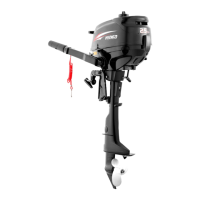Maintanance
Checkpoints
• Fuel system parts leakage
• Fuel line joint leakage
• Fuel line cracks or other damage
• Fuel connector leakage
Inspecting idling speed
WARNING
Do not touch or remove electrical parts when starting or during operation.
Keep hands, hair, and clothes away from the ywheel and other rotating parts while the engine is
running.
CAUTION
This procedure must be performed while the outboard motor is in the water. A ushing
attachment or test tank can be used.
A diagnostic tachometer should be used for this procedure. Results may vary depending on
whether testing is conducted with the ushing attachment, in a test tank, or with the outboard
motor in the water.
1. Start the engine and allow it to warm up fully in neutral until it is running smoothly.
NOTE:
Correct idling speed inspection is only possible if the engine is fully warmed up. If not warmed
up fully, the idle speed will measure higher than normal. If you have difculty verifying the idle
speed, or the idle speed requires adjustment, consult a HIDEA dealer or other qualied mechanic.
2. Verify whether the idle speed is set to specication. For idle speed specications, see page 23
Changing engine oil
WARNING
• Avoid draining the engine oil immediately after stopping the engine. The oil is hot and should be
handled with care to avoid burns.
• Be sure the outboard motor is securely fastened to the transom or a stable stand.
WARNING
• Do not overll the oil, and be sure the outboard motor is upright (not tilted) when checking and
hanging the engine oil.
• If the oil level is above the upper level mark, drain until the level meets the specied capacity.
Overlling the oil could cause leakage or damage.
NOTE:
Change the engine oil after the rst 10 hours of operation, and every 100 hours or at 6-rnonth
intervals thereafter. Otherwise the engine will wear quickly.
NOTE:
Change the engine oil when the oil is still warm.
37

